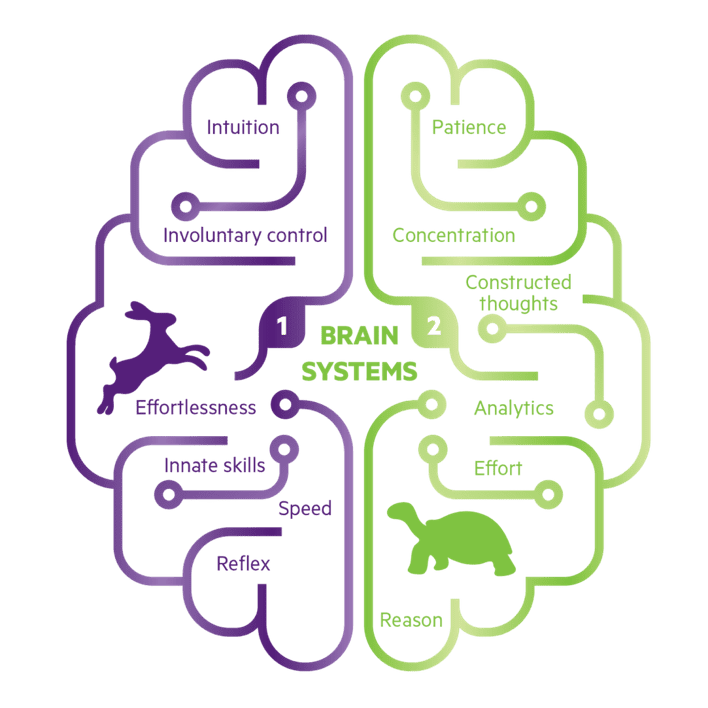How to boost business results by recognizing cognitive biases
In the 1970’s two young psychologists named Daniel Kahneman and Amos Tversky pioneered a new field of study, which eventually became known as behavioural psychology. They were interested in understanding whether humans were rational, economic decision-makers or fallible creatures, vulnerable to mistakes and errors as a result of ‘cognitive load’. Their research suggested that our brains use two ‘systems’ for making decisions:

In the words of Daniel Kahneman, system one ‘runs the show’ but is powered by a range of heuristics, or rules of thumb, which lead to biases and behavioural quirks.
There are now nearly 200 recognized cognitive biases that can affect how we make decisions in a multitude of different ways. Some are fairly well known (e.g. anchoring) whilst others are slightly more obscure (e.g. the false consensus bias).
Either way, all cognitive biases can have significant implications for the way we design and run our marketing, from targeting to creative, from positioning to media placement and pricing. It’s a topic we’ve explored before on Smart Insights but worth revisiting again, this time taking a specific look at B2B marketing.
H2H not B2B
There’s now a common saying within marketing circles that there is no such thing as B2B or B2C, only H2H (human-to-human), an important reminder that regardless of the product, company or industry, we’re always working and selling to fellow human beings.
This insight is important, as it sets the context for why a solid understanding of behavioural science is important within the workplace. When we turn up at work we don’t suddenly transform into ultra-rational decision-makers. We continue to be just as susceptible to the same biases as everyday consumers.
Within the world of B2B marketing, we’re often working on very long, complex sales cycles involving a large number of different decision-makers. We may think that when we’re at work we act and think differently but we must acknowledge our own biases and those of we work with and for.
So what are some of the most common cognitive biases that could influence B2B marketing?
Overconfidence
Most of us tend to overestimate our own abilities. The Dunning-Kruger effect illustrates the cognitive bias of illusory superiority and comes from people’s inability to recognize their limited ability in a particular task or skill. Without the self-awareness of metacognition, we cannot objectively evaluate our true competence or incompetence.
Implications
There could be costly effects on businesses that don’t mitigate against overconfidence. For example, imagine a pitch scenario involving three agencies, two of whom fail to win the contract. The first agency blames everyone but themselves whilst the second carefully reviews not only their performance but that of the winning agency.
The overconfidence of the first agency may result in more wasted time and effort pitching for business for which they are unsuited. A little less confidence and more humility can go a long way!
Applications
The overconfidence bias can also impact how we market to prospects and clients. If the people we target believe they are better than the competition we need to consider the implications for our messaging. In this instance we can use our audience’s belief in their own products to our advantage:
- Run an award scheme for customers to demonstrate the superiority of the products they’re using.
- Gamify your partner marketing programme, encouraging competition and high achievement using your solutions.
- Use wording that suggests pride and achievement, e.g. “your company deserves the best”, “industry-leading companies use X project”.
False consensus
The false consensus effect indicates that we tend to overestimate the extent to which other people are like us. This can be a dangerous mistake for marketers, as demonstrated in research from Thinkbox in 2016, which found that marketers overestimated consumers’ digital habits based on their own habits and lifestyles.
Implications
As the Thinkbox research showed, marketers seem particularly susceptible to this bias, projecting their own lifestyles on to their audiences, assuming they fit into a similar cultural background or demographic. However, basing marketing decisions on assumptions leads to a number of potential complications:
- You can end up focusing on channels and tactics that don’t align with the target audience, leading to creative and media wastage.
- Allowing global marketing teams to dictate local marketing campaigns despite different cultural nuances.
- Creating and targeting inaccurate personas.
Applications
Wherever possible, always base decisions on sound data and test propositions and messaging before going live. Use short ‘pulse surveys’ to test campaign messaging or ethnographic research to test and develop B2B content.
We can also use the false consensus bias to our advantage by making prospects feel that others in their industry are making good decisions to encourage them to make similar decisions to keep up. This might include:
- Suggesting that the target’s competitors are getting ahead of them.
- Using statistics to show that your product/service is the industry standard.
- Using influencer marketing with prominent case studies.
Novelty
We have a natural tendency to favour new things, something illustrated by the fact that stock markets often respond better to the appointment of external CEOs rather than internal promotions. This is despite evidence that external candidates are more likely to be dismissed due to a lack of necessary skills.
Implications
As marketers we’re notorious for chasing after the latest, shiny new object, whether that’s a new social media platform, technology innovation (3D, VR, AR) or sales technique. The appeal of novelty can result in marketers investing prematurely in new technologies and is part of the reason for the ‘peak of inflated expectations’ on the Gartner hype curve.
Focusing too much on novelty can lead to mistakes such as:
- Wasting budget on new technologies that don’t contribute to positive results.
- Weighting marketing plans too heavily towards new tactics and strategies at the expense of the tried and trusted techniques that have worked previously.
- An over-reliance on novelty as a key selling point when audiences may be looking for consistency, track record and/or trustworthiness in your messaging.
Applications
Avoid making snap decisions on ‘new’ marketing gimmicks and focus instead on developing a clear, thorough marketing strategy that aligns with your overarching business goals and objectives. Carefully balance the old and the new and research what will work best for you before jumping in head first.
Positioning yourself as innovative, new or ‘game-changing’ is, ironically, nothing new, and nearly every industry niche has run this type of messaging. Whilst this can be an effective strategy, take time to research the market before running a campaign on ‘novelty’ to ensure you are truly differentiated from the competition.
If this is a route you want to pursue, reinforce this message throughout the marketing mix:
- Prioritize research and statistics from the last few years.
- Remove dates from content you expect to use on an ongoing basis.
- Keep an updated stock of case studies rather than relying on strong ones over the course of many years.
Conclusion
Cognitive biases exist everywhere and affect us whether we are in or outside of work. We are all humans at the end of the day and we must, therefore, be aware of how these cognitive ‘rules of thumb’ influence our behaviour and those of our customers, clients and stakeholders.
False consensus, overconfidence and the appeal of novelty are just three out of many other biases we can look out for and take advantage of as B2B marketers. The trick is to be very self-aware and look for the right opportunities to leverage them ethically as part of your marketing strategy.
